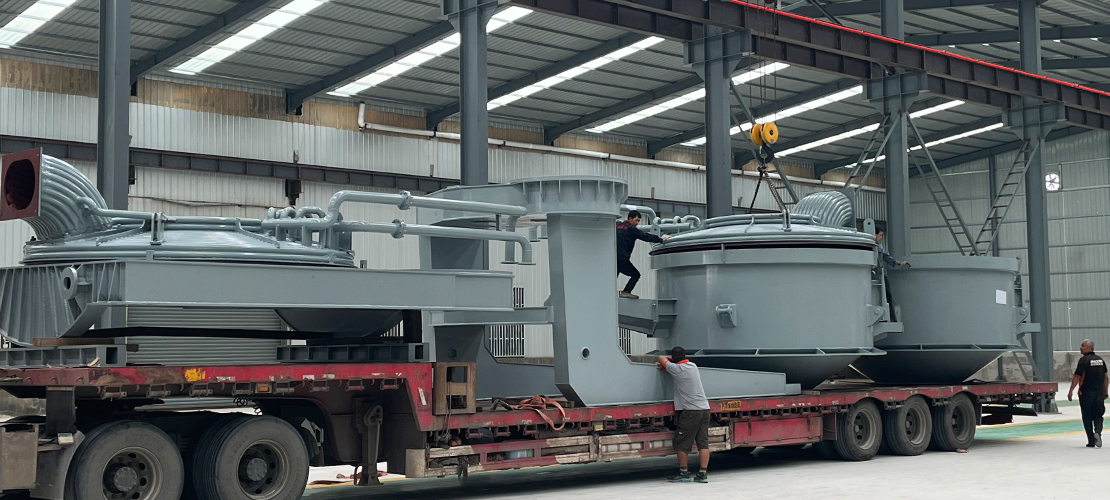Apr. 16, 2025

Electric arc furnace EAF steel production is a method of using electricity to generate high-temperature electric arcs between graphite electrodes and metal materials as heat sources for steelmaking. Its production characteristics are mainly reflected in the following aspects. Let us understand them together.
Adapt to a variety of raw materials: Electric arc furnaces can use 100% scrap steel as raw materials, and can also be used with direct reduced iron (DRI), pig iron, hot briquetted iron (HBI), etc., and their adaptability to raw materials is much higher than that of converters (dependent on molten iron).
Reduce dependence on iron ore: Reduce dependence on the long process of blast furnaces and converters, suitable for resource recycling.
Mainly dependent on electricity: The arc temperature of EAF steel production can reach more than 3000℃, which can quickly melt metal, but the energy consumption is high (usually 300~500 kWh/t steel).
Auxiliary energy: It can be used with auxiliary heating such as oxygen burners and natural gas to improve energy efficiency.
Emission reduction advantage: Compared with the blast furnace converter process, the steelmaking electric arc furnaces has lower CO₂ emissions per ton of steel (about 0.4~0.6 tons, the converter process is about 1.8~2.2 tons), and it is easy to match dust removal and exhaust gas treatment equipment.
Quick start and stop: The electric arc furnace can be started and stopped at any time, which is suitable for intermittent production, while the blast furnace needs to operate continuously.
Short smelting cycle: The smelting cycle of modern electric arc furnace EAF steel production can be shortened to 40~60 minutes (traditional converter is about 30~40 minutes, but it needs to rely on molten iron pretreatment).
Multi-steel adaptation: It can produce high value-added products such as stainless steel, alloy steel, special steel, etc., and its more convenient to switch steel grades.
High temperature & strong oxidizing environment: The local high temperature in the arc zone is conducive to melting refractory alloys, but the redox reaction in the furnace needs to be controlled.
Key to slag control: Improve thermal efficiency, protect furnace lining, and desulfurize and dephosphorize by slag making (such as foam slag technology).
Chemical energy assistance: Modern steelmaking electric arc furnaces use a large amount of oxygen (30~40 m³/t steel) for carbon-oxygen reactions, and use chemical energy to supplement thermal energy.
Low initial investment: The construction cost of electric arc furnace workshop is lower than that of blast furnace converter joint enterprises, but the electricity price is sensitive.
Furnace lining life affects cost: Refractory material loss is large (especially in the slag line area), and regular maintenance is required (furnace lining life is usually 200~500 furnaces).
Electrode consumption: Graphite electrodes account for 5%~10% of the cost, and high-temperature oxidation and fracture need to be strictly controlled.
Emission issues: Waste gas (dioxin, dust) and noise pollution need to be controlled by bag dust removal, closed hoods, etc.
Green upgrade:
Scrap pretreatment: EAF reduces the introduction of impurities (copper, zinc).
Smart smelting: AI is used to optimize the power supply curve and automate loading.
Renewable energy: Combined with green electricity such as wind power and photovoltaic power, the carbon footprint is further reduced.
Sensitive to electricity prices: Electricity costs account for about 30% to 50% of the production cost, which is suitable for areas with low electricity prices or abundant scrap steel resources (such as coastal China, Europe and the United States).
Small-scale economy: Electric arc furnaces are suitable for small and medium-sized steel mills (annual output of 500,000 to 2 million tons), but super-large electric arc furnaces (such as 400 tons) can also achieve economies of scale.
The core advantages of electric arc furnaces EAF steel producing are flexible raw materials, short processes, and low carbon emissions, which are suitable for recycling scrap steel resources and special steel production; the disadvantages are high energy consumption, high electrode costs, and large impact on the power grid. With the increase in scrap steel accumulation and the advancement of carbon neutrality policies, the proportion of steelmaking electric arc furnaces in the steel industry is expected to continue to increase (currently about 25% to 30% globally and about 10% to 15% in China).
Latest News
Electric Arc Furnace Cooling System & Components
Apr. 17, 2025
Electric Arc Furnace EAF Steel Production Features
Apr. 16, 2025
Latest Products
Customized metallurgical machinery and equipment range: Electric Arc Furnace, Submerged Arc Furnace, LF Refining Furnace, Vacuum Furnace, Induction Furnace, Dust Remove System, Water Treatment Equipment, etc. Providing the most advanced equipment integration services, metallurgical equipment can be customized according to different needs of customers, and production capacity can be adjusted according to customer requirements.
Electric Arc Furnace
Submerged Arc Furnace
LF Refining Furnace
VD / VOD Vacuum Refining Furnace
Induction Furnace
Furnace Accessories
Navigation
E-mail: anna@srfurnace.com
Tel: +86 159 2955 5868
WhatsApp: +86 159 2955 5868
Add:
Room 102, Building 7A, Free Trade Xintiandi, Fengdong Avenue, Fengdong New Town, Xi'an City, Shaanxi Province
